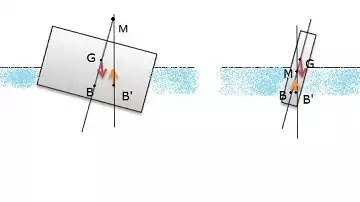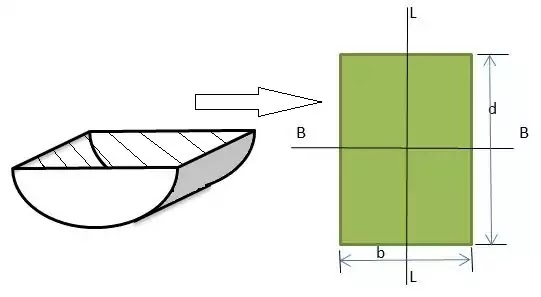BUOYANCY
Definition: -When a body is immersed wholly or partially in a fluid, an upward force is exerted by the fluid on the body.
- This upward force is equal to the weight of the fluid displaced by the body.
- This upward thrust is called Buoyancy and the force is called buoyant force.
- This statement is also known as Archimedes principle.
 |
| Fig.1 | Buoyancy Force |
If a body is immersed in fluid,
P1= Pressure at point ‘1’
P2= Pressure at point ‘2’
A = Area of cross section
ρ = Density of fluid
h1= Depth of point ‘1’ from free surface
h2= Depth of point ‘2’ from free surface
Therefore, Buoyant force (FB) = (P1- P2).A
= ρgA(h2 - h1)
Centre of Buoyancy –It is the point, where the buoyant force supposed to acts.
It is generally denoted by ‘B’.
Stability of submerged Body:
 |
| Fig.2 | Stability of submerged body |
1. Stable Equilibrium –When a slightly disturbing force is act on a submerged body, it comes to its original position.
Condition –When B is above G.
[Where B = Centre of Buoyancy and, G =Centre of Gravity]
2. Unstable Equilibrium –When a slightly disturbing force is act on a submerged body, it cannot come to its original position.
Condition –When B is below G.
3. Neutral Equilibrium –When a slightly disturbing force is act on a submerged body, it neither comes to its original position, nor move widely, stable at another position.
Condition –When B is at G.
Metacentre: -It is the point at which a body starts oscillating when the body is tilted by some angle.
It is also defined as the point where the line of action of buoyant force is intersecting the normal axis of the body, when the body is tilted at some angle.
 |
| Fig.3 | Metacentric Height |
Metacentric Height: - It is the distance between the Centre of gravity and Metacentre.
Stability of Floating Body:
 |
| Fig. 4 | Stability of floating body |
1. Stable Equilibrium
Condition –When M is above G.
[Where M = Metacentre and, G =Centre of Gravity]
2. Unstable Equilibrium –
Condition –When M is below G.
3. Neutral Equilibrium –
Condition –When M is at G.
Determination of Metacentric Height: -
GM= (BM – BG)
= [(I/V) – BG]
Rolling:
The oscillatory motion of a ship or a boat about its longitudinal axis is called rolling.
Pitching:
The oscillatory motion of a ship or a boat about its transverse axis is called Pitching.
 |
| Fig. 5 | Rolling and Pitching |
Ill = bd3/12
Ibb = db3/12
[Where Ill = MI about longitudinal axis
Ibb = MI about transverse axis]
∵ b < d
∴ Ill < Ibb
∵GM = (I/V) – BG
∴ GM)l < (GM)b
- Stability of ship in rolling condition is critical compare to pitching, so ships are designed under rolling.
- Higher the value of GM, Lower will be the time period i.e. lesser will be comfort.
- Metacentric height for passenger ships is in the range of 0.5m to 1m as stability and comfort both should be focus.
- Metacentric height for cargo ships and military ships is in the range of 1.2 m to 1.8m as stability is the prime concern.
Time period of Oscillation:
T = 2π √ [K2/(GM)g]
Where K = Radius of Gyration of the floating body about its C.G.
Or T ∝ 1/ (GM)





0 Comments
Please do not enter any spam link in the comment box